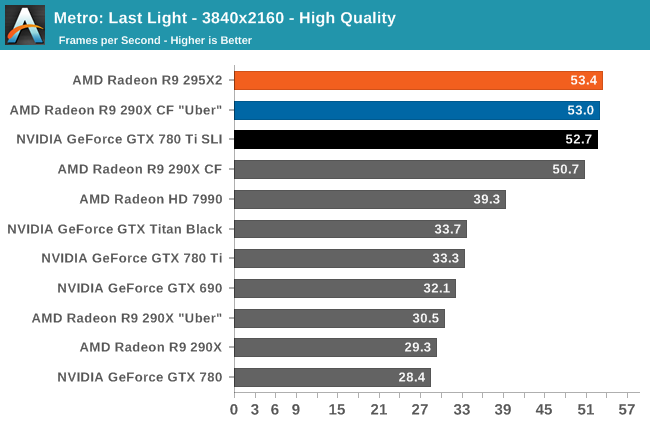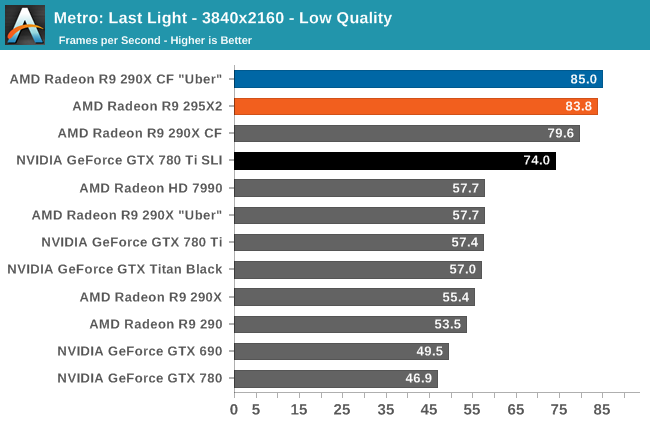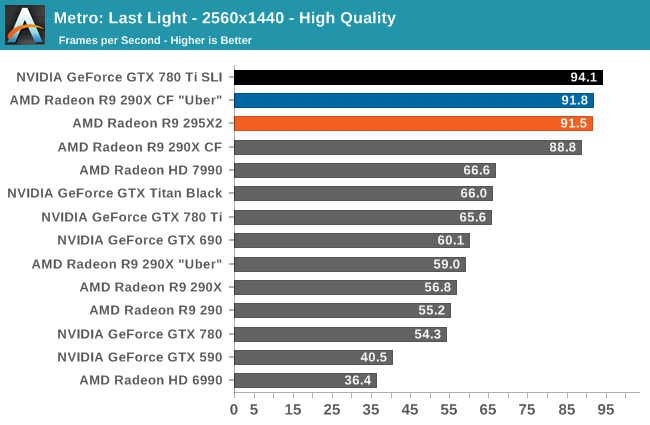The AMD Radeon R9 295X2 Review
by Ryan Smith on April 8, 2014 8:00 AM EST- Posted in
- GPUs
- AMD
- Radeon
- Radeon 200
Metro: Last Light
As always, kicking off our look at performance is 4A Games’ latest entry in their Metro series of subterranean shooters, Metro: Last Light. The original Metro: 2033 was a graphically punishing game for its time and Metro: Last Light is in its own right too. On the other hand it scales well with resolution and quality settings, so it’s still playable on lower end hardware.



Our first gaming benchmark pretty much sets the tone for what we’ll be seeing in this review. In building the 295X2 AMD set out to build a single card that could match the performance of the 290X “Uber” In Crossfire, and that is exactly what we see happening here. The 295X2 and 290XU CF swap places due to run-to-run variation, but ultimately both tie together, whether it’s above the GTX 780 Ti SLI or below it.
As we’ve already seen with the 290X, thanks in part to AMD’s ROP advantage, AMD’s strong suit is in very high resolutions. This leads to the 295X2 edging out the competition at 2160p, while being edged out itself at 1440p. None the less between AMD and NVIDIA setups this is a very close fight thus far, and will be throughout. As for Metro, even at the punishing resolution of 2160, the 295X2 is fast enough to keep this game going at above 50fps.










131 Comments
View All Comments
Dustin Sklavos - Tuesday, April 8, 2014 - link
Single cable is beyond spec for the connector. We've been hearing connectors actually melting. "Crappy" isn't really relevant here; this is the *only* card on the market that causes these kinds of problems.Anders CT - Tuesday, April 8, 2014 - link
500 watt power consumption is insane. It should come with an on-board dieselgenerator.Blitzninjasensei - Saturday, July 12, 2014 - link
The thought of this made my day. Thanks for the joke, needed it.therfman - Tuesday, April 8, 2014 - link
This is all very nice, but unless case space is at a premium, I fail to see the advantage of this card over two 290X cards with good coolers. The PowerColor PCS+ version of the 290X runs at 1050 MHz, is much quieter than the reference boards (40-42 dBA under load at 75cm), and is available for under $600. Is having a single-slot solution worth $300 extra? Not unless you really want have everything in a small form factor case.Peeping Tom - Tuesday, April 8, 2014 - link
Is that a giveaway I hear coming? ;-)silverblue - Tuesday, April 8, 2014 - link
Please, don't... I don't think I could stand to see a card of this calibre being offered only to those in the States... :|JBVertexx - Tuesday, April 8, 2014 - link
Is there any way to tell the temperatures of each of the two GPUs? Where does the temperature reading for the testing come from - is it an average of the 2, the hotter, or the cooler one?Reason I'm asking is I was skeptical a 120mm rad could effectively cool two of these GPUs. Given they are connected in series, one is bound to be measurably hotter than the other.
Otherwise, this looks to be a winner. I was considering upgrading my uATX rig so I could do SLI. But with this card, I could keep the compact form factor.
JBVertexx - Tuesday, April 8, 2014 - link
After some additional research on the web, it looks like the difference in temps between the 2 GPUs is only about 2 degrees under load, so pleasantly surprised with how well the 120mm radiator handles the cooling.Ryan Smith - Tuesday, April 8, 2014 - link
The temperature readings come from MSI Afterburner, which is capable of reading the temperatures via AMD's driver API. And unless otherwise noted, the temperature is always the hottest temperature.srsbsns - Tuesday, April 8, 2014 - link
The point of this driver was improvements the the HD7000 series and their rebrands... Anandtech missed this by benching an already optimized 290x dual card?